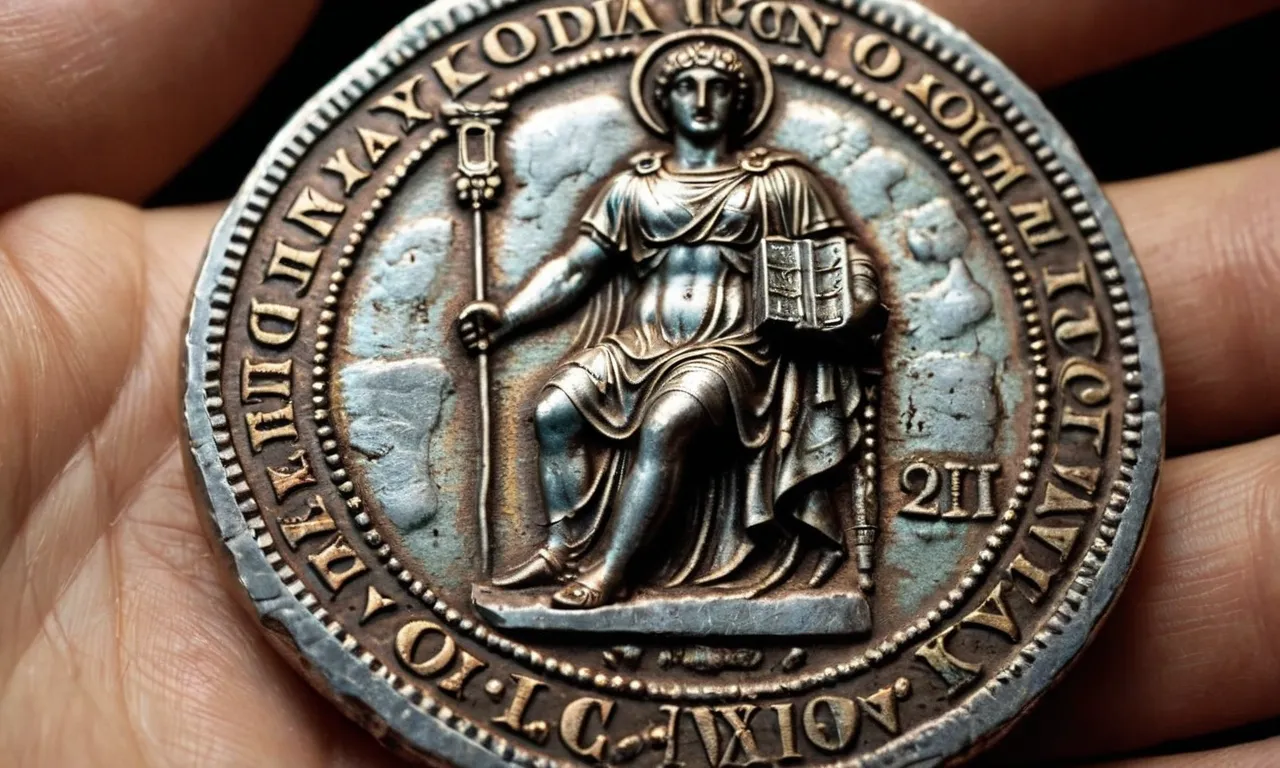How Much Is 2 Denarii Worth In The Bible?
The denarius was an ancient Roman silver coin that was frequently mentioned in the Bible. Understanding the value of a denarius and other coins of the time period can help provide context for various biblical accounts and parables.
If you’re short on time, here’s a quick answer to your question: Based on scholars’ estimates, 2 denarii would have been equivalent to about 2 days’ wages for a common laborer in Jesus’ time.
In this comprehensive guide, we will explore the history of the denarius, examine biblical references to this coin, look at how scholars have estimated its value, and calculate how much 2 denarii would have been worth in New Testament times.
The Origin and History of the Denarius
When the Denarius Was First Struck
The denarius originated as the principal silver coin of the Roman Republic around 211 BCE. Its name comes from the Latin “deni” meaning “containing ten”, as it was initially valued at 10 asses. The as was a bronze coin and the main denomination at the time.
The denarius was introduced as part of a monetary reform aimed at remedying the debased coinage prevalent during the Second Punic War against Carthage. Roman authorities sought to create a stable and trusted currency system. The denarius quickly became the backbone of Roman commerce and finance.
The earliest denarii featured a helmeted head of Roma on the obverse and the Dioscuri twins Castor and Pollux on the reverse. This design honored the Roman Republic’s mythical origins. Later denarii depicted living rulers, deities, military symbols, and other politically significant images that reflected current events.
The Buying Power of a Denarius
In the late Roman Republic, around the time of Jesus, a denarius represented the daily wage for a common laborer. Sources like the Gospel of Matthew 20:2 refer to a denarius as the amount paid for a day’s work.
Some historians estimate the purchasing power of a denarius then was equivalent to between $20-$40 today. While not hugely valuable itself, the silver denarius allowed everyday market transactions in Ancient Rome. Soldiers received 225 denarii a year as pay.
A Roman legionnaire could buy a tunic for 2 denarii or a pair of sandals for half a denarius.
As the principal silver coin, the denarius financed the Roman Empire’s trade economy and military expansions. Debasement of the denarius with cheaper metals was often used to fund wars and building projects.
By the 2nd century CE, rampant inflation from devaluation caused economic troubles that contributed to the Empire’s decline.
The denarius remained in use through the Late Antique era until it was replaced in the 4th century by other coins like the silver siliqua. Nonetheless, the long history of the denarius exemplifies its importance in the Roman world for centuries.
Biblical References to the Denarius
The Denarius in the Gospels
The denarius was frequently mentioned in the Gospels as a common coin used in Judea during Jesus’ time. Here are some key references:
- In the Parable of the Workers in the Vineyard (Matthew 20:1-16), the landowner agrees to pay the first workers one denarius for a day’s work.
- When asked whether it is lawful to pay taxes to Caesar, Jesus replies “Render to Caesar the things that are Caesar’s, and to God the things that are God’s” (Matthew 22:15-22). The taxes were to be paid in denarii.
- In the Widow’s Offering, Jesus honors the widow who gave two small copper coins, worth only a fraction of a denarius (Mark 12:41-44).
- Judas Iscariot was paid 30 pieces of silver to betray Jesus, which was equivalent to 120 denarii according to Exodus 21:32 (Matthew 26:14-16).
These passages give us an idea of the common usage of the denarius as a wage for a day’s labor, as a tax coin, and as a standard amount for transactions in Judea at the time.
The Denarius in the Book of Revelation
The denarius also appears symbolically in the prophetic Book of Revelation:
- In Revelation 6:6, a “quart of wheat” is valued at a denarius, indicating scarcity in the end times. This shows the denarius retained its function as a wage even in the prophetic visions.
- The famous “mark of the beast” passage links the number 666 to the value of a person in denarii: “it also forced all people, great and small, rich and poor, free and slave, to receive a mark on their right hands or on their foreheads, so that they could not buy or sell unless they had the mark, which is the name of the beast or the number of its name.
This calls for wisdom. Let the person who has insight calculate the number of the beast, for it is the number of a man. That number is 666.” (Revelation 13:16-18)
The association of 666 with the denarius suggests the antichrist system in Revelation will financially control people by linking human value to money and transactions. The denarius represents the unifying currency marking those inside and outside of God’s kingdom.
These examples demonstrate the importance of the denarius as a unit of currency in the biblical world. Though a common coin, its symbolic usage in key passages gives us insight into the economic and spiritual order of the New Testament era.
Understanding the value of a single denarius can shed light on the meaning of some powerful scriptural themes.
Estimating the Value of a Denarius
Wages and Prices in Ancient Times
In biblical times, a denarius was a common daily wage for a laborer. Several passages in the New Testament give us an idea of the value of a denarius in terms of what it could buy.
For example, in Matthew 20:1-16, workers were hired to work in a vineyard for one denarius per day. In Luke 7:41-43, a debtor owed his creditor 500 denarii, suggesting this was a sizable debt.
We also find some information about prices. A measure of wheat cost about one denarius (Revelation 6:6). Mary’s offering of nard worth 300 denarii was seen as extravagant (John 12:5). Judas was paid 30 pieces of silver for his betrayal of Jesus, with each piece being a tetradrachma worth approximately one denarius (Matthew 26:15).
From these examples, we can infer that one denarius represented good pay for a day’s labor, and could buy modest quantities of commodities like wheat and oil. Larger quantities of denarii signified substantial sums of money.
Scholarly Estimates of a Denarius’ Value
While it’s impossible to assign an exact modern value to an ancient currency, scholars have made some educated estimates about the denarius:
- A denarius was likely 1/60th of a Roman pound of silver. Estimates for the value of a pound range from $600 to $1200 in today’s dollars.
- Based on wages and prices at the time, a denarius is often estimated to be worth around $20 in modern terms.
- Accounting for inflation, some estimates for a denarius are as high as $160-$400 in today’s purchasing power.
- Daily wages for labor estimated around 1 denarius in the New Testament would equate to $80-$250 per day in current US dollars.
Of course, it’s difficult to provide precise equivalents across 2,000 years of history. But most scholars believe the denarius represented significant buying power as a standard day’s wage in ancient times. The estimates give us a reasonable basis for understanding its value.
Key to grasping the value of a denarius is understanding typical wages and prices back then. While the precise modern equivalent is elusive, we can reasonably infer from Bible passages that the denarius was an important monetary unit and held considerable worth.
Calculating the Value of 2 Denarii in the Bible
2 Denarii as a Typical Day’s Wages
In the Bible, a denarius was the usual payment for a day’s labor (Matthew 20:2). For example, when Jesus told the parable of the workers in the vineyard, the landowner agreed to pay the first workers “a denarius for the day” (Matthew 20:2).
So 2 denarii would be equal to 2 days’ wages for a common laborer in biblical times.
According to historical records, an average day’s wage for a laborer in the 1st century AD Roman Empire was about 1 denarius. But the actual purchasing power of 1 denarius varied quite a bit based on inflation and other economic factors.
Using historical estimates, in today’s money 2 denarii would have been worth something like $35 to $165 in current US dollars. But it’s difficult to peg an exact equivalent due to differences in prices for goods between societies.
What Items Could Be Purchased With 2 Denarii?
Ancient Roman and Judean societies were quite different economically compared to today. But to give a sense of purchasing power, here are some examples of what common laborers may have been able to buy with 2 denarii based on historical records:
As you can see, 2 denarii went much further in ancient societies compared to their equivalent value in today’s money. But even though a denarius was a common wage, many day laborers would have still lived at a modest if not impoverished standard.
Matthew 20 illustrates that 2 denarii was considered “fair” payment for 2 days labor. So using it as a benchmark shows how little money laborers and many common people survived on in ancient times. The subsistence living conditions that many faced even with full time work reflects the vast economic inequality present in those societies.
Conclusion
In the time of Jesus and the early Christian church, the denarius was one of the most frequently used Roman coins. While it’s difficult to provide an exact value across different time periods, scholars estimate one denarius was equivalent to about one day’s wages for a laborer in the New Testament era.
Based on these estimates, 2 denarii would have represented approximately 2 days’ wages. This could provide for basic necessities for a day or perhaps purchase common items like salt, lamp oil, or sacrificial doves in the temple.
Understanding the estimated value of coins like the denarius can shed new light on the meaning of biblical texts.







